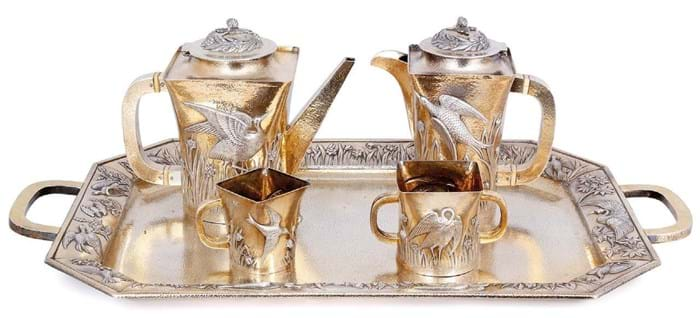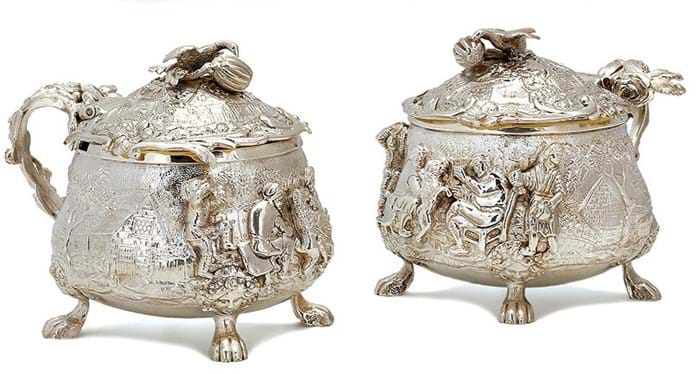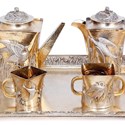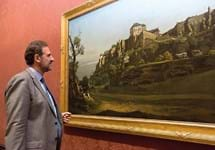A prime example was the traditional Silver & Vertu auction on July 19. Here, with the champagne corks yet to pop, the highlight was a nice cup of tea.
It is hard to remember the last time an Edwardian/George V tea and coffee service aroused the sort of international interest shown in the silver parcel gilt ‘Japonisme’ style offering illustrated above.
Comprising a teapot, coffee pot, milk jug and sugar bowl on a 2ft (60cm) long tray, it was variously marked for London goldsmiths Wakely & Wheeler, the Manchester retailer Finnigans and various date letters for 1905, 1912 and 1919.
Chiswick silver expert John Rogers guided it at £3000-4000, which he considered a “confident estimate, especially for a 20th century tea set not by a famed individual designer/maker”.
It seems likely that the service was made for the family of the vendor and entirely produced by Wakely & Wheeler. The model was unusual and the Aesthetic movement design dubbed by Rogers “a masterpiece of the chaser’s art”.
“The details and workmanship of the repoussé puts this at the height of skill for the manufacturer at the time,” he said.
Bidders concurred and the service sold to an Eastern collector at £10,000.
Mustard pots
Another table silver entry to more than double expectations was a pair of mustard pots by Edward Farrell, London 1821.
The 4in (10cm) tall pots, illustrated above, were decorated in the Teniers style, with embossed scenes of Dutch houses and cast and applied figures.
These ornate pots by Farrell – a favourite of royalty and high society in his day – are rare but are not an unknown form: in January 2016 a single similarly bucolic pot sold at California auctioneers John Moran for $1700 (then about £1200).
The pair at Chiswick was estimated at £1500-2000 and sold to “an international dealer/collector” at £5000.
The same buyer purchased standard silver pieces among the 460 lots, around 70% of which got away to total £116,000.
Among them was a 13in (34cm) tall, twin-handled cup and cover by Lewis Herne & Francis Butty, London, 1760. The 55oz baluster-shaped cup was chased and embossed with flowers and the cover featured a crest of a mermaid looking into a mirror and combing her hair. It sold comfortably above estimate at £1900.
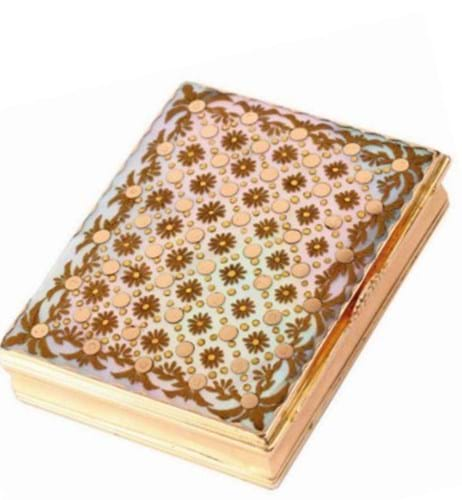
A c.1720-30 unmarked gold and mother-of-pearl piqué snuff box – £3000.
Vertu brought its rewards, most notably in the cases of two French snuff containers. One, a c.1700 4¼in (10.5cm) long curved snuff horn with unmarked gold mounts and gold piqué inlaid shell sections, sold to a London buyer described as a serious collector above estimate at £4000.
The second, a c.1720-30 unmarked gold and mother-of-pearl piqué snuff box, 2in (5cm) long, was inlaid to the rectangular lid with circles and flower heads. It went to the trade on the lower £3000 estimate.
In the frame
The surprise among the vertu at Chiswick was a framed daguerreotype c.1845.
“It is our opinion that early photography can be seen as an object of vertu,” said Rogers, whose background includes a Masters from the Royal College of Art in the subject of analogue photography.
“Contemporaneously viewed in such a way like portrait miniatures, these early examples of photography were mounted in gilt brass and housed in tooled leather cases revealing their intimate curious nature,” he said.
The 4¾ x 3½in (12 x 9cm) example at Chiswick with (probably) the original glass was notable for the subject matter of three choir boys turning sheet music rather than a simple portrait. Multiple figures presented technical difficulties for the photographer.
It sold to ‘an international collector’ at £1100 against an estimate of £200-300.


